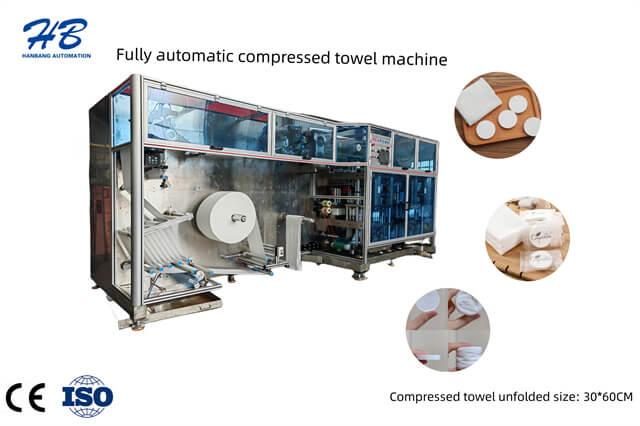Author:HB Nonwoven MachineryFROM:Compressed Towel Machine Manufacturer TIME:2023-10-23
Introduction:
The non-woven fabric industry has experienced significant growth in recent years, driven by the increasing demand for products such as diapers and sanitary napkins. One of the crucial machines used in this industry is the non-woven fabric slitting rewinding machine. This article will explore the various applications of this machine and its importance in the production process.

The first and most important application of the non-woven fabric slitting rewinding machine is in the production of diapers. This machine is used to slit and rewind the non-woven fabric into the desired width, which is then used as the top or backsheet of the diaper. The high-speed operation and precise cutting capabilities of the machine ensure efficient production and consistent quality of the diapers.

In the sanitary napkin manufacturing industry, the non-woven fabric slitting rewinding machine plays a crucial role. It is used to slit and rewind the non-woven fabric into the required width and length for the production of sanitary napkins. The machine's ability to handle different types of fabric and achieve accurate cuts is essential in maintaining the integrity and performance of the final product.

Non-woven fabrics are extensively used in the medical industry for various applications such as surgical gowns, masks, and wound dressings. The non-woven fabric slitting rewinding machine is employed to slit and rewind the fabric into the appropriate size for these medical products. The machine's precision and reliability are critical in ensuring the safety and effectiveness of these medical supplies.
Many household cleaning products, such as wet wipes and floor mops, utilize non-woven fabrics. The slitting rewinding machine is utilized to cut and rewind the fabric, allowing manufacturers to produce these products in different sizes and shapes. The versatility of the machine enables the production of a wide range of non-woven fabric-based cleaning products that cater to diverse consumer needs.
The automotive industry also utilizes non-woven fabrics in various applications, including car upholstery and interior linings. The non-woven fabric slitting rewinding machine is used to slit and rewind the fabric into precise dimensions required for these automotive components. The machine's efficiency and accuracy are critical in meeting the high production demands and quality standards of the automotive industry.
Non-woven fabrics find applications in agriculture and horticulture, such as crop protection covers and nursery bags. The non-woven fabric slitting rewinding machine is employed to cut and rewind the fabric into the desired size and shape according to the specific agricultural or horticultural application. This machine plays a vital role in enabling efficient and cost-effective production of these fabric-based materials for the agriculture sector.
The packaging industry extensively uses non-woven fabrics for various purposes, including product packaging, gift wraps, and tote bags. The non-woven fabric slitting rewinding machine allows manufacturers to cut and rewind the fabric into different sizes and lengths, catering to the packaging requirements of diverse products. The machine's speed and accuracy ensure efficient production and attractive packaging designs.
Non-woven fabrics are becoming increasingly popular in the furniture and home furnishings industry due to their durability and versatility. The slitting rewinding machine is used to cut and rewind the fabric into the desired widths for applications such as upholstery, curtains, and bedding materials. The machine's ability to handle large rolls of fabric and deliver precise cuts ensures optimal utilization of the non-woven fabric in this industry.
The non-woven fabric slitting rewinding machine is an essential equipment in various industries, including diaper production, sanitary napkin manufacturing, medical products, household cleaning products, automotive, agriculture, packaging, and furniture. Its ability to slit and rewind non-woven fabric with precision and speed plays a critical role in ensuring the efficient production and consistent quality of products in these industries. The continuous advancements in the technology of this machine have further enhanced its performance and expanded its applications, contributing to the growth and development of the non-woven fabric industry as a whole.





